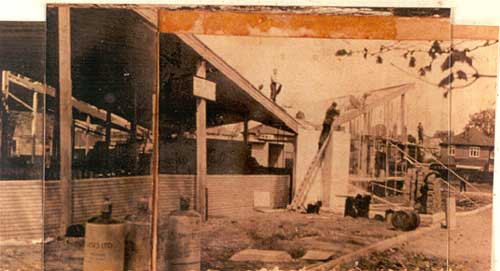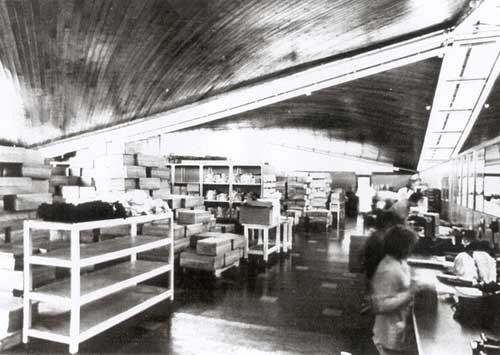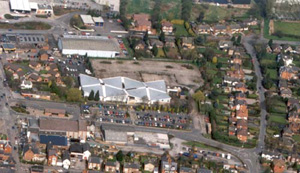This website uses cookies
This website uses cookies to enable it to function properly and to analyse how the website is used. Please click 'Close' to accept and continue using the website.






April 2002 - Silhouette Factory, Shropshire
In August 2000 an unusual building was added to the List of Buildings of Special Architectural or Historic Interest. The former Silhouette Corset Factory in Market Drayton, Shropshire, was a pioneering example of laminated timber engineering. The huge uninterrupted space, required for the manufacturing of foundation garments, was designed as eight hyperbolic paraboloid timber shell roofs supported on a single central column.
Internally the building consists of 120’ by 240’ of clear space with only one central support. Above, the curved timber roofs appear to arch and sag dramatically. Ribbon rooflights at the junctions of the shells throw light into the centre of the space and help articulate the structure. Flexible screens to house storage and office areas divide each end of the space.
Robert Townsend designed the factory in 1959-60 with the structural engineer Hugh Tottenham, assisted by Ove Arup and Partners. It was commissioned by George Lobbenberg, a corset manufacturer, who had been impressed by Townsend and Tottenham’s earlier factory in Wilton. This building had been the first use of timber in a hyperbolic paraboloid roof in Britain and its construction was sponsored by the Timber Research Association. Market Drayton was a development of this earlier example and a more sophisticated building.
The DCMS list description describes the structure thus – “a hyperbolic paraboloid is a true doubly curved surface allowing a thin skin to be held in tension, and any section parallel to an edge appears as a straight line or gable.” Externally the edges of the paraboloids form high gables infilled by curtain glazing on a brick plinth. Because of the nature of the structure the corners appear unsupported.
This in a very unusual and groundbreaking structure and was rightly listed as a building of great significance. As Townsend and Tottenham’s Wilton factory has been demolished, Silhouette remains the oldest structure of its type in the UK and is of undoubted architectural and historical importance. Unfortunately, its future is very bleak. After the original users moved out the factory was opened as a supermarket, a use that would appear to suit its internal volume. However, it has recently become been empty and vulnerable to vandalism.
A new owner, the LIDL supermarket chain, now wants to demolish it and erect one of its own standard trading units. Yet it is a structure that could easily be adapted to supermarket use – with a potential to be a considerably more attractive shopping environment than a great many out of town retail sheds. With many supermarket chains now recognising the benefits of high quality and unusual architecture to their marketing strategies it is a shame that this opportunity cannot be grasped here.
English Heritage, which supports the building’s retention and reuse, commissioned a condition report from the original structural consultants, Ove Arup and Partners, which confirmed that the building was basically sound and capable of repair. Yet the local authority, North Shropshire District Council, have given Listed Building Consent for its demolition. What is more surprising, the Secretary of State has chosen not to call the application in for further examination. This is somewhat unusual when the application involves the total destruction of a listed building.
Unless the owner has a change of heart it is inevitable that the former factory will be lost. It is not only a tragedy that a building that was recognised by statutory listing so recently may be demolished. It also brings into question the effectiveness of the present system of statutory protection. One wonders whether the Secretary of State would have shown a bit more interest were the listed building to be demolished a Georgian house or Victorian town hall rather than a twentieth century factory.
Look for past Buildings of the Month by entering the name of an individual building or architect or browsing the drop down list.

Become a C20 member today and help save our modern design heritage.